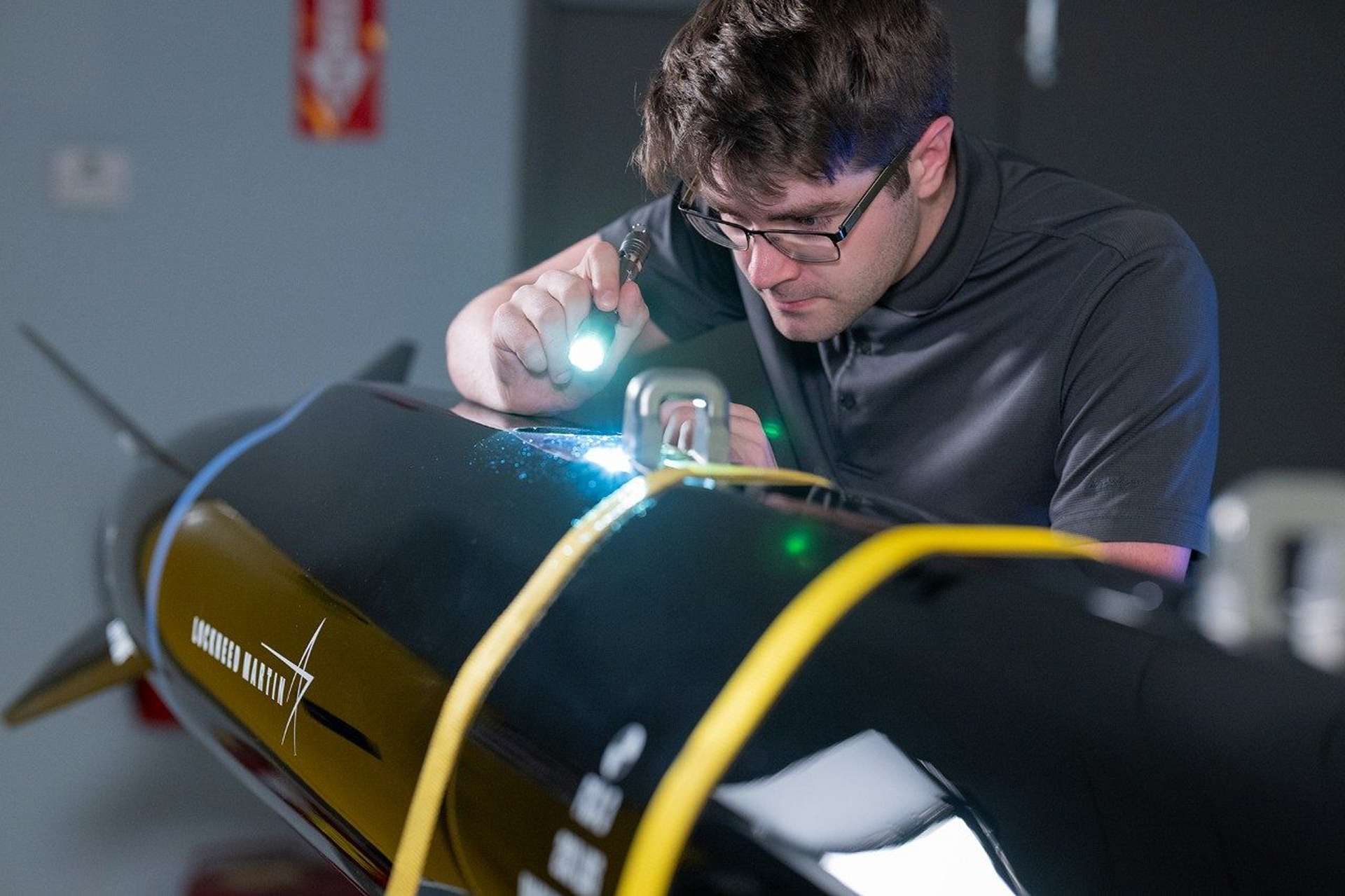Lockheed Martin’s new Mako hypersonic missile to equip almost all US aircraft

{loadposition bannertop}
{loadposition sidebarpub}
On June 23, 2024, Lockheed Martin released new details about the air-launched hypersonic Mako Missile, which promises to be the first hypersonic weapon in the world that can be launched from the internal weapons bay of not just the F-35 but the F-22 Raptor as well. This new missile, which has already been fit-checked for external carriage on nearly any aircraft in the U.S. arsenal, has been described by Lockheed officials as a “multi-mission” weapon system capable of maritime strike, counter-air defense, and various surface-attack operations.Follow Army Recognition on Google News at this link
The Mako hypersonic missile has been tested for external carriage on various platforms including the F-15E, F-16C, F-35 Lighting II in A and C variants, F-A/18 Super Hornet, and F-22 Raptor. (Picture source: US DoD)
Alex Hollings reported that Lockheed Martin has confirmed that the Mako missile has been successfully fit-checked for internal carriage in the F-22 Raptor as well as the F-35A and C models. The physical fit-checks involved a surrogate weapon, ensuring compatibility with the weapons bays of the F-35C, which shares the same weapons bay as the F-35A, and the F-22. Additionally, the missile has been tested for external carriage on various platforms including the F-35, F-A/18 Super Hornet, EA-18G, F-15E, F-16C, and P-8A. Virtual fit checks were also conducted for external carriage on the F-22, F-15C, and F-15EX, and internal carriage in the B-1B, B-52H, and B-21.
Lockheed Martin envisions a tactical use case for the Mako missile where a fifth-generation fighter acts as a forward observer, relaying target data back to a fourth-generation fighter equipped with the Sniper Networked Targeting Pod and Mako missiles for engagement. This strategy could significantly increase the firepower available to America’s stealth fighters while allowing older platforms to play a vital role in combat operations against highly contested targets.
Originally developed for the U.S. Air Force, and despite the advancements and potential of the Mako missile, the Department of Defense has not yet committed to further funding its development or production. However, the US Navy has included it in the Other Transaction Authority (OTA) basket, which allows for potential funding allocation when available. This new missile, under development for seven years, has been described by Lockheed officials as a “multi-mission” weapon system capable of maritime strike, counter-air defense, and various surface-attack operations.
The Mako’s compatibility with standard 30-inch (76-centimeter) lugs means that the Mako missile could become a significant new long-range weapon in the US missile’s arsenal, alongside the recently revealed AIM-174B air-to-air missile. (Picture source: Lockheed Martin)
The Mako missile was developed under the Air Force’s Stand-In Attack Weapon (SiAW) program, with Lockheed Martin receiving approximately $35 million in developmental contracts. The aim was to field a weapon capable of countering China’s anti-access/area denial (A2/AD) assets in the Pacific, necessitating a weapon that is both quick and powerful. Traditionally, hypersonic missiles have been too large to fit inside the internal weapons bays of stealth fighters due to their large rocket motors and fuel stores.
However, the Mako missile’s ability to be launched from within stealth fighters like the F-22 and F-35 significantly increases the potential attack vectors, complicating matters for air defenses. The Mako missile’s high-speed capabilities allow for stealth aircraft to fly out ahead, locate a target, and relay the target data back to Mako-armed fourth-generation fighters for engagement.
Lockheed Martin has confirmed that the Mako missile has already been fit-checked for external carriage on the F/A-18 Super Hornet, EA-18G Growler, F-15E Strike Eagle, F-16C Fighting Falcon, and P-8A Poseidon. In effect, this weapon is designed to be carried by nearly any aircraft in the U.S. arsenal with standard 30-inch (76-centimeter) lugs. This compatibility means that the Mako missile could become a significant new long-range weapon in the US missile’s arsenal, alongside the recently revealed AIM-174B air-to-air missile.
Like the Tomahawk, the Mako missile could increase the firepower available to various US military branches, including the US Air Force, the US Army, and the US Navy. The Mako missile is designed for external carriage on nearly any aircraft in the US arsenal and can be fired from the vertical launch tubes on Navy warships if equipped with a booster, similar to the AGM-158C LRASM. This allows for potential integration into multiple branches, depending on future funding and production decisions.
The Mako missile’s modular design supports the rapid integration of mission-specific elements like warheads and seekers, embracing the concept of open system architecture, but applied to hypersonic missiles. (Picture source: Lockheed Martin)
Named after the fastest shark in the sea, the Mako missile is designed for multi-mission capabilities. It weighs 590 kilograms, is 4 meters long, and 33 centimeters in diameter. The missile’s guidance section and fins are produced through additive manufacturing, significantly reducing production time and costs. Lockheed Martin’s digital engineering approach has also enabled a more mature design at the onset of operational testing. The Mako missile’s modular design supports rapid integration of mission-specific elements like warheads and seekers, embracing the concept of open system architecture. This design ensures that the Pentagon is not beholden to Lockheed Martin for future upgrades, aligning with broader initiatives to make military technologies easier and cheaper to upgrade over their service lives.
According to an article published in The Telegraph on July 23, 2024, Lockheed Martin expressed its willingness to develop the Mako missile in the UK before moving production to the United States. The company highlighted the potential for technology sharing under the AUKUS agreement, which involves the UK, US, and Australia. Tim Cahill, president for missiles and fire control at Lockheed Martin, emphasized that such collaborative efforts could help each nation prioritize defense spending effectively amid constrained budgets. The Mako missile, capable of being launched from fighters such as the F-35, represents the type of versatile weapon that could benefit from international cooperation.
The Telegraph article further notes that the UK Ministry of Defence (MoD) is actively seeking to develop a sovereign hypersonic missile capability by 2030 and is working with numerous companies to evaluate options. The Mako missile, already benefiting from years of design work, could be a strong candidate for this initiative. Cahill mentioned that the UK should focus on addressing capability gaps, and Lockheed Martin is prepared to partner with British companies on production and supply chain efforts. This approach aligns with the broader goals of the AUKUS agreement, aiming to enhance technological capabilities across the participating nations.
The Mako was developed to field a weapon capable of countering China’s anti-access/area denial (A2/AD) assets in the Pacific, necessitating a weapon that is both quick and powerful. (Picture source: Lockheed Martin)

{loadposition bannertop}
{loadposition sidebarpub}
On June 23, 2024, Lockheed Martin released new details about the air-launched hypersonic Mako Missile, which promises to be the first hypersonic weapon in the world that can be launched from the internal weapons bay of not just the F-35 but the F-22 Raptor as well. This new missile, which has already been fit-checked for external carriage on nearly any aircraft in the U.S. arsenal, has been described by Lockheed officials as a “multi-mission” weapon system capable of maritime strike, counter-air defense, and various surface-attack operations.
Follow Army Recognition on Google News at this link
The Mako hypersonic missile has been tested for external carriage on various platforms including the F-15E, F-16C, F-35 Lighting II in A and C variants, F-A/18 Super Hornet, and F-22 Raptor. (Picture source: US DoD)
Alex Hollings reported that Lockheed Martin has confirmed that the Mako missile has been successfully fit-checked for internal carriage in the F-22 Raptor as well as the F-35A and C models. The physical fit-checks involved a surrogate weapon, ensuring compatibility with the weapons bays of the F-35C, which shares the same weapons bay as the F-35A, and the F-22. Additionally, the missile has been tested for external carriage on various platforms including the F-35, F-A/18 Super Hornet, EA-18G, F-15E, F-16C, and P-8A. Virtual fit checks were also conducted for external carriage on the F-22, F-15C, and F-15EX, and internal carriage in the B-1B, B-52H, and B-21.
Lockheed Martin envisions a tactical use case for the Mako missile where a fifth-generation fighter acts as a forward observer, relaying target data back to a fourth-generation fighter equipped with the Sniper Networked Targeting Pod and Mako missiles for engagement. This strategy could significantly increase the firepower available to America’s stealth fighters while allowing older platforms to play a vital role in combat operations against highly contested targets.
Originally developed for the U.S. Air Force, and despite the advancements and potential of the Mako missile, the Department of Defense has not yet committed to further funding its development or production. However, the US Navy has included it in the Other Transaction Authority (OTA) basket, which allows for potential funding allocation when available. This new missile, under development for seven years, has been described by Lockheed officials as a “multi-mission” weapon system capable of maritime strike, counter-air defense, and various surface-attack operations.

The Mako’s compatibility with standard 30-inch (76-centimeter) lugs means that the Mako missile could become a significant new long-range weapon in the US missile’s arsenal, alongside the recently revealed AIM-174B air-to-air missile. (Picture source: Lockheed Martin)
The Mako missile was developed under the Air Force’s Stand-In Attack Weapon (SiAW) program, with Lockheed Martin receiving approximately $35 million in developmental contracts. The aim was to field a weapon capable of countering China’s anti-access/area denial (A2/AD) assets in the Pacific, necessitating a weapon that is both quick and powerful. Traditionally, hypersonic missiles have been too large to fit inside the internal weapons bays of stealth fighters due to their large rocket motors and fuel stores.
However, the Mako missile’s ability to be launched from within stealth fighters like the F-22 and F-35 significantly increases the potential attack vectors, complicating matters for air defenses. The Mako missile’s high-speed capabilities allow for stealth aircraft to fly out ahead, locate a target, and relay the target data back to Mako-armed fourth-generation fighters for engagement.
Lockheed Martin has confirmed that the Mako missile has already been fit-checked for external carriage on the F/A-18 Super Hornet, EA-18G Growler, F-15E Strike Eagle, F-16C Fighting Falcon, and P-8A Poseidon. In effect, this weapon is designed to be carried by nearly any aircraft in the U.S. arsenal with standard 30-inch (76-centimeter) lugs. This compatibility means that the Mako missile could become a significant new long-range weapon in the US missile’s arsenal, alongside the recently revealed AIM-174B air-to-air missile.
Like the Tomahawk, the Mako missile could increase the firepower available to various US military branches, including the US Air Force, the US Army, and the US Navy. The Mako missile is designed for external carriage on nearly any aircraft in the US arsenal and can be fired from the vertical launch tubes on Navy warships if equipped with a booster, similar to the AGM-158C LRASM. This allows for potential integration into multiple branches, depending on future funding and production decisions.

The Mako missile’s modular design supports the rapid integration of mission-specific elements like warheads and seekers, embracing the concept of open system architecture, but applied to hypersonic missiles. (Picture source: Lockheed Martin)
Named after the fastest shark in the sea, the Mako missile is designed for multi-mission capabilities. It weighs 590 kilograms, is 4 meters long, and 33 centimeters in diameter. The missile’s guidance section and fins are produced through additive manufacturing, significantly reducing production time and costs. Lockheed Martin’s digital engineering approach has also enabled a more mature design at the onset of operational testing. The Mako missile’s modular design supports rapid integration of mission-specific elements like warheads and seekers, embracing the concept of open system architecture. This design ensures that the Pentagon is not beholden to Lockheed Martin for future upgrades, aligning with broader initiatives to make military technologies easier and cheaper to upgrade over their service lives.
According to an article published in The Telegraph on July 23, 2024, Lockheed Martin expressed its willingness to develop the Mako missile in the UK before moving production to the United States. The company highlighted the potential for technology sharing under the AUKUS agreement, which involves the UK, US, and Australia. Tim Cahill, president for missiles and fire control at Lockheed Martin, emphasized that such collaborative efforts could help each nation prioritize defense spending effectively amid constrained budgets. The Mako missile, capable of being launched from fighters such as the F-35, represents the type of versatile weapon that could benefit from international cooperation.
The Telegraph article further notes that the UK Ministry of Defence (MoD) is actively seeking to develop a sovereign hypersonic missile capability by 2030 and is working with numerous companies to evaluate options. The Mako missile, already benefiting from years of design work, could be a strong candidate for this initiative. Cahill mentioned that the UK should focus on addressing capability gaps, and Lockheed Martin is prepared to partner with British companies on production and supply chain efforts. This approach aligns with the broader goals of the AUKUS agreement, aiming to enhance technological capabilities across the participating nations.

The Mako was developed to field a weapon capable of countering China’s anti-access/area denial (A2/AD) assets in the Pacific, necessitating a weapon that is both quick and powerful. (Picture source: Lockheed Martin)





